Defenders Wanted ... looking for a job?
 HEB Security Site Monitor Position Open
HEB Security Site Monitor Position Open
HEB has two vacancies and will conduct interviews for others. They are looking for tranisitoning Security Forces types with Personnel Protection training and experience.
Security Site Monitor (2 openings)
Here is the link to the position. https://heb.taleo.net/careersection/ex-corporate/jobdetail.ftl?job=18016787&tz=GMT-05%3A00
A few things about the position:
- It’s shift work. We have three shifts – 6a – 2p, 2p – 10p, 10p – 6a. They rotate shifts once a month and need to be able to work all three shifts, work OT, and be on call.
- This is part of a small team monitoring security cameras (CCTV) for our executive team (several residences and business locations). They are the eyes and ears for the
Executive Protective agents. They monitor the cameras but don’t respond to incidents (the EP agents or SAPD, etc. would be called by the Security Site Monitor to respond).
- Because of the confidential nature of the role, we cannot have anyone in position with a close friend or relative that currently works for H-E-B.
- A unique factor that candidates also need to know is that they will not be able to move into other areas of the company after being in this role (sensitive nature of the position) and since the team is so small there are no promotional opportunities.
- We are looking for someone with a security background, especially if they have experience monitoring CCTVs. A degree is a plus but not required.
Executive Protection (no active openings but would like to conduct exploratory interviews)
- Provides armed protection to H-E-B executive (driving, close protection duties)
- They travel to events with their protectee and may be away up to 2 weeks at a time
- Should be humble, intelligent, adaptable, well-spoken, well-groomed in appearance, and confidential
- Must have several years of direct EP level experience with a high value client, well trained
- We are looking for someone who wants to stay in position for several years
- They cannot have relatives or close friends currently with H-E-B
****************
![]()
Centerra Los Alamos
Position Title: CAS/CUAS Supervisor
Department: PF Operations
Hourly Wage Range $38.79
JOB PURPOSE
This supervisory position is responsible for directing and controlling the Central Alarm Station (CAS) operations and supervising CAS personnel. It provides day to day
supervision and direction to CAS and SAS operators during routine operations and during any required security and/or emergency response operations. This position identifies CAS staffing needs and develops staffing analysis reports. In addition, this position has direct oversight and accountability for Counter Unmanned Aerial Systems (CUAS) Operations, including monitoring, detection, identification, tracking and neutralization of unauthorized UAS activity within LANL’s restricted air space. It provides direction to other area PF supervisors regarding the use of secondary CUAS systems.
Communicates with Emergency Management and Response (EM&R) in regards to a UAS situation and the compensatory measures required after employment of CUAS measures, including the initiation and coordination of render-safe operations for downed platforms.
MINIMUM QUALIFICATIONS
- Associates degree or four (4) years’ experience in security or related field.
- Minimum two years Protective Force security experience with Department of Energy armed security operations.
- Demonstrated tactical leadership, oversight and supervisory skills and knowledge of security practices.
- Ability to speak and write in a grammatically correct, professional, effective manner, drafting correspondence, proofreading text, coordinating the work of others, preparing reports.
- Supervisory skills to include leading personnel, directing work assignments and tactical responses, planning, organizing, scheduling, team building, problem solving, conflict resolution, and directing activities of assigned employees.
- Must be able to react, provide direction, leadership and support under any type of emergency conditions.
- Intermediate-level computer skills that include all the Microsoft Office Suite of software.
- Required to successfully complete Site Specific Training Programs, OJT and maintain proficiency.
- Currently have or be able to obtain and maintain a Department of Energy (DOE) Q
-Clearance and be certified/volunteer for the Human Reliability Program (HRP).
- Ability to obtain and maintain a valid driver’s license.
- Successfully complete site specific CAS/ CUAS training course and certification designed to provide the minimum level of skills and knowledge needed to competently perform all tasks associated with job responsibilities.
- Must be available to work extended hours (day and night).
- Must be able to work in remote and austere environments.
DESIRED QUALIFICATIONS
- Certification as a CUAS operator with neutralization authority and Certification as a UAS pilot/pilot in command; prior military experience as UAS operator (Army MOS 15W/Air Force MOSC 1U0X1).
- Central Alarm Station Supervisory experience.
- Knowledge of and experience with early detection and alarm systems, and/or closed circuit television (CCTV) monitoring systems.
NOTE: (Internal Applicants) Discipline on file does not disqualify an applicant.
However, discipline on file will be taken into consideration as part of the hiring process.
TO APPLY:
INTERNAL APPLICANTS: Internal applicants who are qualified and interested
MUST submit a resume and cover letter describing in detail how your experience meets the minimum and additional desired position qualifications. Internal applicants are not required to submit a new employment application. Email your resume and cover letter by the close date to This email address is being protected from spambots. You need JavaScript enabled to view it.
EXTERNAL APPLICANTS: External applicants who are qualified and interested
MUST complete both of the outlined steps below.
- Complete the online application process for this position by visiting the following link:
http://www.centerragroup.com/careers.html
- Select—“Jobs at Centerra!” Search by: Los Alamos
- Submit a cover letter describing in detail how your experience meets the minimum and additional desired position qualifications. Email your cover letter to This email address is being protected from spambots. You need JavaScript enabled to view it.
POSITION CLOSE DATE: Tuesday, August 7, 2018 at 5:00PM (MST) Contact Brandy at 505-665-7521 if you have any questions regarding this posting.
Benchmark! Way to go McConnell!

Kudos to Maj Gen Sharpy and the AMC leadership team for what Chief Hartz just witnessed at McConnell AFB. Her visit was intended to assist the unit with transitioning to our new shift schedule, predicated upon 8-hours of armed duty, protected time off, and scheduled reconstitution time. It turns out not only do they not need our help (they transitioned without our presumed manpower assist) they have essentially checked the box on every Reconstitute Defender Initiative we have which involves their mission set.
They accomplished this because of the support of their Wing leadership and in the words of their Defense Force Commander, Major John Farmer, "it just takes hard work and not pushing the easy button." Their Security Forces Manager, Chief Rebecca McNelley, is leading the charge and has her Defenders motivated to generate airpower.
For those who may think McConnell is a sleepy hollow, I don't believe such a thing exists in our Air Force -- this unit made it happen in the midst of working KC-46 bed down, an open house air show, an aggressive MAJCOM and Wing exercise schedule, and the need to relocate squadron facilities (the photo of the wood pile is what they are reclaiming and turning into unit farewell plaques through self- help). Everyone has a full plate.
1st Leaders Led Trainer
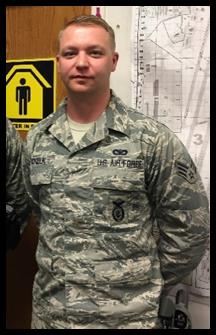
Automated Fingerprint Training
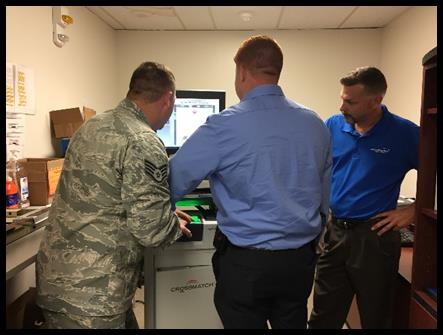
Total Force Integration Training
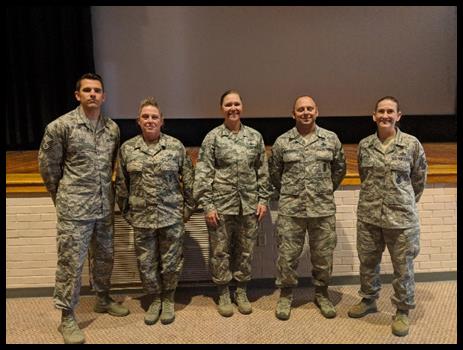
Reconstitute Defender Initiative in Action!
- New Shift Schedule - 8 hours armed
- MSgts leading/coaching/mentoring as Flight Chiefs
- Reconstitution Time Built into Schedule
- Protected Time Off
- Surge Capability
- Leader Led Trainers deliver training on-duty
- Firearms simulator in use—Milo system
- Sending Defenders to Tiered Training
- Expended 75% of ammo, requested/received more for sustainment firing
- Enhancing Installation Access Control Points to eliminate perimeter breaches
- Culture and history—prideful unit
- Team of teams—UDM initiative benchmark
Root Canal Gets Canine Warrior’s Bite Back
By: Daisy Grant, The Journal Record , Tinker Take Off, 5 July 2018
Kevan Goff-Parker, Staff Writer
One of Tinker Air Force Base’s 72nd Security Forces Squadron K9 team members, Aruba, a German shepherd, age 4, recently suffered a chipped tooth during a Military Working Dog demonstration after he was commanded to attack a man wearing a bite suit on May 29.
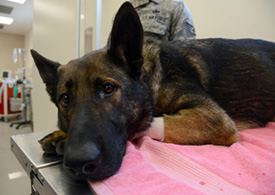
Military Working Dog Aruba, a four-year-old German shepherd, relaxes outside of the surgery suite in the vet clinic before his procedure to have a new crown fitted to one of his canine teeth. (U.S. Air Force photo/Kelly White)
Aruba’s handler, Airman 1st Class Marco Arroyo, said he and Aruba were doing bite work on controlled aggression training when one of his dog’s canine teeth broke off. Despite his injury, Aruba kept working.
“I heard a break, like a stick snapping, and saw his tooth fly in the air, but he didn’t give up,” Arroyo said. “I had to take him off because he was still biting. He’s one of the youngest dogs, very energetic and hungry to learn, but I was very concerned.”
Fortunately, Veterinarian Dr. Heather Cameron was in the audience along with visiting U.S. Army Lt. Col. Sidney M. Cobb Jr. Once Arroyo saw that his MWD’s tooth was bleeding, they immediately took Aruba to the vet clinic so Cameron could examine him. She provided pain management to make him comfortable for the night, and took X-ray images the next day.
Upon examining the X-rays, Cameron discovered Aruba needed a root canal. She then called U.S. Air Force Comprehensive Dentist Maj. (Dr.) Heather Brooks with the 72nd Dental Squadron, to see if she was interested in performing the procedure
“We don’t usually do root canals or crowns, but we discovered we could save a good chunk of the root — the actual part of the tooth that sits on the gum line,” Cameron said. “That’s always a better option for a Military Working Dog because it helps him maintain that bone as he ages, and Aruba’s only 4 and has a good, long working life ahead of him in the future. We’ve worked with Maj. Brooks and the 72nd Dental Squadron before and they’ve been very helpful and willing to help us out.

Airman 1st Class Marco Arroyo comforts a 72nd Security Forces Squadron K9 team member Aruba before his root canal. (U.S. Air Force photo/Amy Schiess)
“Dr. Brooks has a lot more experience on root canals than I do because they do them every day. The last one I did was four years ago, so if she was willing to do it, I’d rather have that quality of care for my Military Working Dogs.”
Brooks said she was thrilled to have the opportunity. She had actually saved a lecture she had heard five years before about performing root canals on the military’s canine warriors.
“It’s a good thing I’m a hoarder,” Brooks said, laughing. “I kept all those lectures. The irony was, I was briefed during my first residency at Travis Air Force Base and you never know you might get the opportunity to do this. I really studied up!”
Brooks said the biggest difference between dog and human teeth is that dog’s teeth, especially canine teeth, are significantly longer and the curvature is different. Cameron, Brooks and both vet clinic and 72nd DS staff assisted with the root canal. Aruba received a kiss from Arroyo, then anesthesia and Brooks got busy. The operation lasted more than two hours.
“Aruba had a deep break, so we had to do a little bit of dental heroics,” Brooks said. “We don’t have dental trays for dogs, so we created an impression tray and made a putty mold of his teeth. Aruba’s canine teeth are huge at 3.5 centimeters long, so we had some MacGyver moments, because while they had some of the equipment we needed, human dental instruments aren’t large enough for a dog’s tooth.
“In a perfect world I would have post drills for dogs, but we just had human drills so we did the best we could. We took out the nerve, cleaned it out and disinfected the tooth, put the filler in and sealed it and irrigated the area.”
Maj. (Dr.) Heather Brooks and Airman 1st Class Eliza Patton, with the 72nd Dental Squadron, along with Dr. Heather Cameron, Tinker veterinarian, work together to prepare MWD Aruba’s tooth for his new crown. (U.S. Air Force photo/Kelly White)
Because of the way Aruba’s tooth broke, Brooks decided to create a crown with a post, primarily because she didn’t want the dog to be sedated three times. On June 18, the team reconvened and inserted Aruba’s new crown. It is silver and made of high noble metal alloy.
Brooks described Aruba as “adorable” and said she enjoyed watching him do laps with Arroyo. She and the team also took photos of Aruba and his handler.
Arroyo said he found the root canal process interesting and felt confident that Aruba was in good hands.
“It was cool watching the root canal and going through the process and learning how everything works,” he said. “It was pretty exciting and the best thing I got out of that was when he woke up and was fine. It felt nice seeing him getting fixed up like that because he’s like my child.”
Arroyo said on June 26 that Aruba is doing great after his follow-up visit.
“He’s ready to rock and roll, he’s good to bite and to get back to work,” he said
The long-awaited OCP uniform is on its way to the Air Force — and here’s when you could get it
By: Stephen Losey, 14 May 2018, Air Force Times
The wait is over: OCPs are here.
For years, airmen have dreamed of it, demanded it, and envied those lucky enough to have it already.
And now, finally, the Operational Camouflage Pattern uniform on its way. For everybody.
The Air Force announced Monday that it is adopting the Army’s OCP as its official utility uniform. The uniform will roll out across the force over the next three years.
While some airmen already wear the OCP ― such as airmen in the Middle East and Air Force Global Strike Command security forces ― the Air Force will start rolling it out to others beginning Oct. 1.
By April 1, 2021, all airmen will be required to wear the OCP, and the current airman battle uniform, or ABU, will be no more.
“Our airmen have made it clear, with a resounding, ‘Hey, we want to get into this uniform as soon as we possibly can,’” Maj. Gen. Robert LaBrutta, the Air Force’s director of military force management policy, said in a May 9 interview at the Pentagon. “Downrange and in garrison, [airmen consistently reported] it’s a better utility uniform than the ABU.”
LaBrutta said Air Force Chief of Staff Gen. Dave Goldfein and Chief Master Sergeant of the Air Force Kaleth Wright made the decision and were backed by Air Force Secretary Heather Wilson.
“We looked at all utility uniforms currently in our inventory to find the best of breed,” Goldfein said in a release Monday. “We spoke to and listened to airmen on this, and the OCP was the clear choice. The uniform works in all climates ― from Minot to Manbij ― and across the spectrum of missions we perform. It’s suitable for our airmen working on a flight line in Northern Tier states and for those conducting patrols in the Middle East.”
The OCP was chosen for three reasons: Its improved fit and comfort will make it easier for airmen to do their jobs, it will help airmen fit in alongside soldiers in the field and improve joint integration, and airmen consistently said they wanted the switch.
Operational Camouflage Pattern
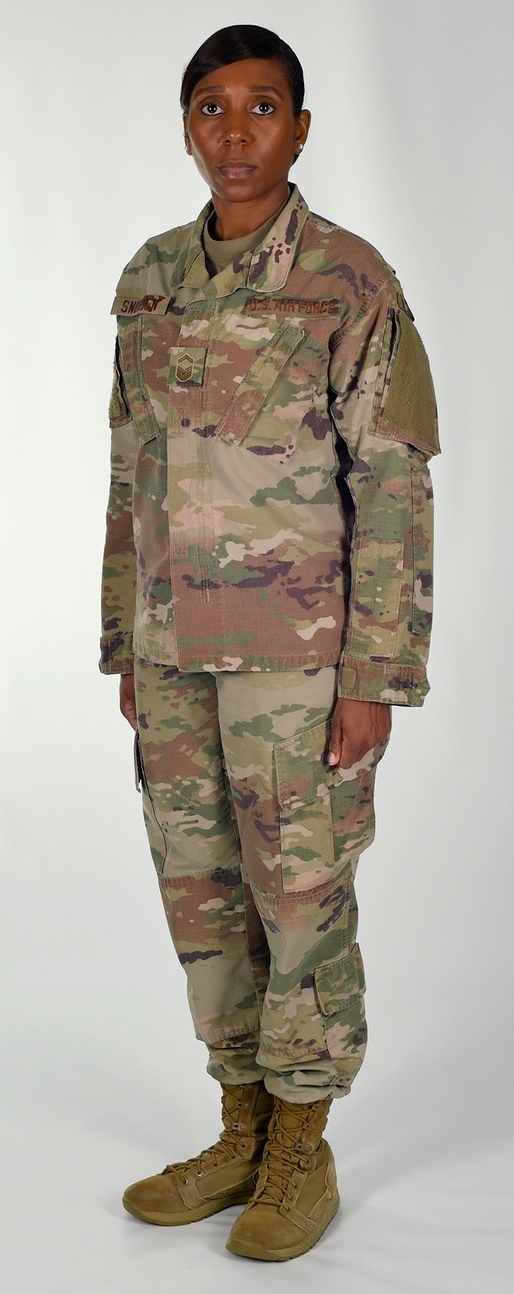
The Air Force plans to switch completely over to the Operational Camouflage Pattern uniform by April 1, 2021. (Air Force)
“The OCP is a uniform for form, fit and function,” LaBrutta said. “It is the best of breed utility uniform that we believe is in the inventory that we can get into. And, as a result of that, our airmen are going to benefit from enhanced readiness through the use of the OCP.”
Air Force officials determined early on ― after receiving overwhelmingly positive feedback from airmen already wearing it ― that the OCP was the way to go, LaBrutta said. The question was, largely, how quickly to roll it out.
Since 2012, the OCP has been airmen’s combat utility uniform. It was first approved for airmen deployed to Afghanistan, so they would blend in alongside soldiers while on patrol, and later expanded to other Middle East locations.
About 100,000 airmen have worn the OCP downrange since 2012, and about 20,000 airmen currently wear it both deployed to U.S. Air Forces Central Command, and in garrison when guarding Global Strike Command facilities. Air Force Special Operations Command airmen and aircrews in Air Mobility Command also wear the OCP.
Their feedback has helped the Air Force make decisions on adopting the OCP across the force, LaBrutta said.
Goldfein, Wright and Wilson have also heard a great deal of interest in the OCP from airmen while traveling to bases.
It will also simplify life for airmen, who won’t have to maintain two different sets of utility uniforms.
“It just makes sense that we would have one utility uniform, instead of two,” LaBrutta said.
The OCP has a six-color palette and smooth lines, allowing its camouflage to better blend in to various environments, Global Strike Command said in 2014, when it started switching its security forces to that uniform.
ABUs, on the other hand, have a four-color, pixelated camouflage pattern that does not blend in as well.
“If you get in a firefight in the field and you’re laying down fire, who are you going to see first? Obviously that guy” in ABUs, Chief Master Sgt. Scott Daigneault, then-senior enlisted manager for the force improvement program at Global Strike Command, said in a 2014 release announcing the change. “The difference is almost night and day. Your eyes skim right over the guy in OCP and zone in on the guy in ABUs.”
When AFCENT in 2012 adopted OCPs as its official uniform for airmen deployed to Afghanistan, the command said the uniforms were chosen because they are comfortable, flame resistant and blend in well with Afghanistan’s terrain.
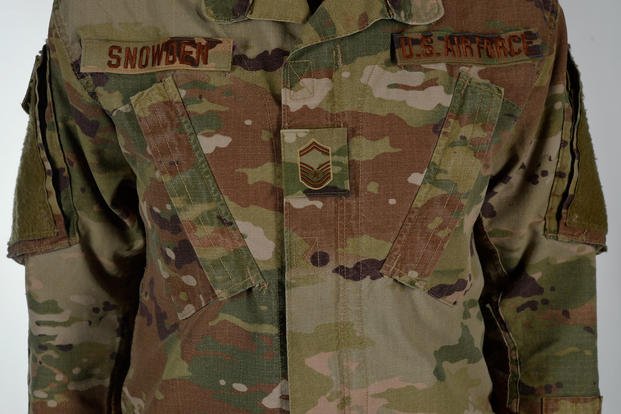 Airmen will wear their rank in the middle of their chest -- instead of on the sleeves or collars and the uniform will have Velcro pockets on the chest. (Air Force)
Airmen will wear their rank in the middle of their chest -- instead of on the sleeves or collars and the uniform will have Velcro pockets on the chest. (Air Force)
These uniforms are eagerly anticipated by airmen ― so much so that Wright stirred up a hornet’s nest online in March when he posted photos on social media of himself wearing the OCP.
One commenter wondered if his photos were a “savage tease or friendly foreshadowing?” Others online suggested the photos were ”Troll level 1000,“ or “rubbing it in.”
This prompted a mea culpa from Wright, who denied any hidden message or attempt at trolling. Wright explained he only sought to blend in during his visit to the 27th Special Operations Group at Cannon Air Force Base in New Mexico, which already wore the OCP.
“Wow! I never thought I’d have to start of a post with ‘my bad’ but ... my bad!” Wright wrote online soon afterward.
When you’ll get it
Here’s the timeline for the rollout of the OCP:
July 2018: The Air Force expects to release an Air Force guidance memorandum on how to properly wear the OCP uniform.
Oct. 1: ”Optional wear” of the OCP will begin. That means anyone who already has the uniform hanging in his or her closet ― such as from a previous deployment to Afghanistan ― will be able to wear it.
Also that month, OCPs will go on sale at AAFES stores at a handful of bases ― Aviano Air Base in Italy, Joint Base Charleston in South Carolina, MacDill Air Force Base in Florida, and Shaw Air Force Base in South Carolina.
The Air Force will gradually expand from there, as the Defense Logistics Agency ramps up its ability to produce more of the new uniforms.
April 1, 2019: More AAFES stores ― but not yet all ― will start to get the OCP.
Oct. 1, 2019: New airmen coming in through basic military training, officer training school, and the Reserve Officer Training Corps will get their OCPs beginning next October, when LaBrutta said the production capacity is expected to be able to meet that demand.
Military training instructors and military training leaders will also start wearing OCPs at that time, to demonstrate proper dress and appearance standards to trainees.
AAFES is expected to start selling OCPs online next October as well.
June 2020: All airmen must transition to coyote brown boots. The old sage green boots, which most airmen wear with their ABUs, or desert sand boots, worn by some who already have OCPs, will no longer be allowed.
April 1, 2021: The final deadline for all of the more than 500,000 total force airmen to be wearing OCPs, and stop wearing ABUs once and for all.
The new OCP will cost about $20 more than the ABU, LaBrutta said. It will take the Air Force until this October to increase airmen’s clothing bag allowance by that amount, which is another reason why the service is waiting until fall to start allowing airmen to wear it. The coyote brown boots will cost about the same as the old boots, he said.
The Air Force also wants airmen who already have OCPs to switch over at the same time, where possible, which is why optional wear isn’t beginning before October, he said.
“It’s a heavy lift,” LaBrutta said of DLA’s effort to provide OCPs for both the Army and the Air Force. “It’s going to take some time for us to be able to field this across the United States Air Force. Folks are going to have to be patient.”
Get ready for squadron patches
Enlisted airmen will no longer wear their rank insignia on their sleeves, and officer insignia won’t be on their collars anymore. Instead, officers and enlisted will both wear rank insignia in the middle of their chests.
Airmen will also have their last names on the back of their patrol caps.
The Air Force will use a spice brown color for lettering, patches and most insignia, LaBrutta said, as opposed to the black used by the Army on their OCPs.
First lieutenant and lieutenant colonel insignia will be black, to differentiate them from second lieutenant and major insignia. The uniform configurations will otherwise be the same as the Army’s version.
And as part of an effort to build esprit de corps and revitalize the squadron structure of the Air Force ― one of Goldfein’s top priorities ― airmen will wear heraldry patches on their new uniforms alongside the U.S. flag.
“Folks like to pay tribute to their organizations,” LaBrutta said. “And so the patches, from a squadron perspective, are going to be part of the uniform as well. They’ll have to meet the color requirements that we have, and we’ll get that out to them. But squadron patches, heraldry patches will be on the uniform.“
In a follow-up email, Air Force spokeswoman Maj. Kate Atanasoff said headquarters patches and the U.S. flag will be worn on the right shoulder, and unit patches and authorized duty identifiers ― such as security forces, combat controller or Tactical Air Control Party ― will be worn on the left shoulder. The guidance coming out this summer will provide more detail on proper wear of patches.
As organizations design their new patches, they will have to use spice brown, as well as other specific thread colors that will be authorized by the Air Force.
“Unit patches express squadron identity and heritage ― something our airmen are incredibly proud of and want to celebrate,” Goldfein said.
So-called morale shirts, which were color-coded by squadron, are going away, Air Force spokeswoman Brooke Brzozowske said.
Patches will be velcroed on, but LaBrutta said airmen will be able to choose whether they velcro or sew on their name tag and U.S. Air Force tag.
Pockets on the chest will be at the same slanted configuration as on the Army’s OCP, and will velcro shut. Pockets on the arms will have side zippers, Atanasoff said.
The Air Force’s current sage green boots will be no more, and the service will transition into the coyote brown boots. Airmen will no longer be able to wear desert sand boots, as some currently do with their OCPs.
Old boots will be disposed of, but there will not be a buy-back.
LaBrutta said airmen could wear a tan t-shirt under the OCP, which he said matches well with the coyote brown boots. Airmen will continue wearing the so-called “DLA green” socks, he said, which are similar in color to tan. The belt will also be tan.
“The chief and the chief master sergeant of the Air Force, they want to make sure that we’re looking as professional as we possibly can in this uniform, thus the color patterns and everything,” LaBrutta said.
Airmen will also be able to roll their sleeves in this uniform, Atanasoff said.
The Air Force will use the Army’s inventory of backpacks and other equipment, to make sure it matches the new uniforms.
When stacked up against the current ABU, the Army’s OCP fits better and is more comfortable, LaBrutta said. It will likely last about as long as the old ABU before it wears out, he said.
“Those that wear the uniform, day in and day out, say that it actually wears better,” LaBrutta said. “In the operations that we’re wearing the uniform in, whether it’s a defender at Air Force Global Strike Command, or a battlefield airman, they believe it’s a better uniform to actually do their duties in.”
Atanasoff said the old and new uniforms have the same fabric weight, and the same 50-50 nylon cotton blend. The OCP will have no permanent press treatment, as the ABU initially had, and the OCP will have an “insect shield” permethrin treatment.
The uniform will simply be called the OCP, not the Airman Combat Uniform, as it has previously been called.
The switch will come with a hefty up-front price tag ― about $237 million over the first three years, to dispose of all the old boots and uniforms that will no longer be needed.
LaBrutta said one reason the Air Force stretched the adoption over three years was to draw down the old inventory as much as possible.
Some old ABUs could be handed down to JROTC units, LaBrutta said.
But over time, as the Air Force no longer has to pay for tens of thousands of airmen to keep up two different sets of utility uniforms, LaBrutta expects the service will break even.
“There are up-front investment costs any time you transition into something like this,” LaBrutta said. “But in the long term, it will be a break-even for the United States Air Force. The benefit that we’re going to get out of this in readiness, joint integration, and the airman demand signal that’s out there, are the reasons why we’re doing this, and very worthwhile.”
Deployed airmen who will go outside the wire will still receive a fire-resistant version of the OCP, LaBrutta said.
Pilots and other rated airmen will continue to wear their usual flight suits when performing rated duties, he said, but will wear OCPs like everybody else at other times.
LaBrutta said the women’s version of the OCP will have 20 different sizes. Female airmen who have worn the OCP while deployed to AFCENT have said it fits them much better than the women’s version of the ABU, he said.
Women will also have the option of wearing the unisex version of the OCP.
“The feedback that we’ve received from the women that have worn it in Air Forces Central Command has been very positive,” LaBrutta said. “So that’s another reason for moving into this new equipment item.”
Stephen Losey covers Air Force leadership and personnel issues as the senior reporter for Air Force Times.
These are the Air Force’s 12 Outstanding Airmen of the Year
By: Victoria Leoni and Noah Nash, Air Force Times, 23 June 2018
The Air Force has announced this year’s Outstanding Airmen of the Year winners.
The 12 winners represent the service’s top enlisted members and were selected from a pool of 36 nominees based on their superior leadership, job performance and personal achievements.
The winners are listed below in alphabetic order.
Senior Master Sgt. Melissa Beam, Air Combat Command
Staff Sgt. Elizabeth Caulfield, Air Force District of Washington
Staff Sgt. Wilson Gardner, Air National Guard
Senior Master Sgt. Ruth Griffin, Air Force Global Strike Command
Tech. Sgt. Brett Laswell, Air Force Special Operations Command
Master Sgt. Kit Lui, Air Force Reserve Command
Master Sgt. Joshua Matias, Air Education and Training Command
Tech Sgt. David Miller, U.S. Air Forces in Europe
Senior Airman Patrick Schilling, Air Force Materiel Command
Tech Sgt. April Spilde, Air Force Space Command
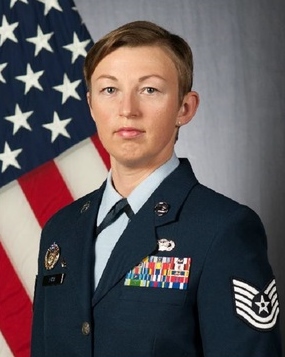
CONGRATS DEFENDER!!!!
Tech Sgt. April Spilde, Air Force Space Command, a Bravo flight chief at Vandenberg Air Force Base in California, leads 135 airmen securing $10.2 billion in space launch assets. A native of Minneapolis, Spilde has been stationed in Alaska and Washington, D.C., and has also been deployed to Afghanistan and the United Arab Emirates since joining the Air Force in 2008.
Senior Master Sgt. Lucero Stockett, Air Mobility Command
Senior Airman Jon Taitano, Pacific Air Force
Page 27 of 50


